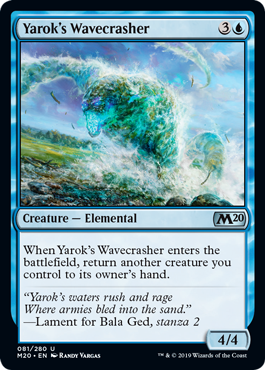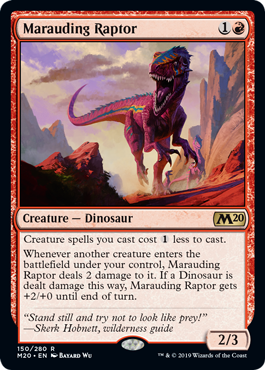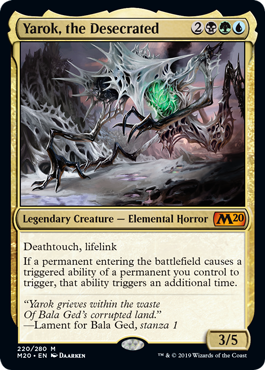Edited 19 July, 2019
It’s that time again: time for a brand new set from Wizards, Core Set 2020! After the whirlwind of rules phenomena we found in Modern Horizons and War of the Spark, this set is a return to fundamentals. With a few surprises, of course; Protection tentatively returning is an exciting twist! And as always, what we’re here for: triggers. Some straight-forward, and some a bit more complicated, that fall on one side or the other of the upgrade to Warning. Here is everything you need to know to make sure you can recognize these triggers correctly.
The Missed Triggers Project has identified six (6) triggers that upgrade when missed from Core Set 2020:
“0: Create two 1/1 red Elemental creature tokens. They gain haste. Sacrifice them at the beginning of the next end step.”
This Chandra only has one triggered ability, but that trigger makes us sacrifice tokens. And since keeping tokens is generally desirable, losing them is generally detrimental. As this ability undoes a zone change, it is important that regardless of how many turns have passed, we resolve the ability; let the opponent choose whether to resolve it immediately, or before anyone would get priority at the start of the next phase.
“At the beginning of your upkeep, discard a card.”
Not to call out the dinosaur in the room, but WOW this thing is large for its cost. It figures this card would have a downside, and I don’t know about you but I generally like having cards in my hand. This trigger is considered generally detrimental.

“When Yarok’s Wavecrasher enters the battlefield, return another creature you control to its owner’s hand.”
Keeping your creatures on the battlefield is typically desirable. And while this set has a sub-theme of enter-the-battlefield triggers that can turn this drawback into a benefit, we don’t take the text of any other cards into account when evaluating triggers. So even though we’ll see a lot of players trying to make the most of it, this trigger is still going to upgrade to a Warning any time it’s missed.
“When Lotus Field enters the battlefield, sacrifice two lands.”
Tapping for 3 mana is great! Losing 2 lands is…less great. While this trigger makes the card a “fixed” version of its predecessor, Lotus Vale, it is still definitely a drawback, so this trigger will upgrade to a Warning when missed.
“…Return that card to the battlefield tapped and attacking. Sacrifice it at the beginning of the next end step.”
Similar to Chandra, Acolyte of Flame, sacrificing creatures on your end step is generally detrimental. This triggered ability also undoes a zone change, so it is important that regardless of how many turns have passed, we resolve the ability; let the opponent choose whether to resolve it immediately, or before anyone would get priority at the start of the next phase.
 “Whenever another creature enters the battlefield under your control, Marauding Raptor deals 2 damage to it. If a Dinosaur is dealt damage this way, Marauding Raptor gets +2/+0 until end of turn.”
“Whenever another creature enters the battlefield under your control, Marauding Raptor deals 2 damage to it. If a Dinosaur is dealt damage this way, Marauding Raptor gets +2/+0 until end of turn.”
This one is a little bit more complicated, and has a lot to unpack. Its deals damage to your own creatures; seemingly to offset the benefit of Raptor’s cost reduction and the possibility of the +2/+0 boost. That cost reduction is powerful, and +2/+0 is nothing to sneeze at…But 2 damage should be taken pretty seriously as well. Taking full advantage of this discount means only playing creatures that can survive the trigger. And since we’re evaluating it in a vacuum, it’s important that we ignore things that could benefit from self-inflicted damage such as the Enrage keyword often found on Dinosaurs. With all of that in mind, we’ve decided that this trigger is generally detrimental (and will upgrade to a Warning), even if we expect players to squeeze as much positive value out of it as they can.
While the following cards do not have triggers that upgrade, they are certainly honorable mentions:

“+2: Each opponent gets an emblem with “At the beginning of your upkeep, this emblem deals 1 damage to you.”
First and foremost, we have our dear mythic Chandra. There are a few important points to remember when dealing with this card out in Competitive REL tournaments. To start, the emblem is both owned and controlled by the opponent who receives it [Comprehensive Rules 113.2], so from a game rules perspective it is technically their trigger to remember. And as always, players are NOT allowed to intentionally forget their own triggers; doing so is considered Cheating. This trigger also is generally detrimental; however, this trigger should never result in a Warning. We only apply the upgrade path if a player “own[s] the card responsible for the existence of the trigger”. And while NAP owns the Chandra Emblem, the AP owns the Chandra (the actual card that’s responsible here).
So to recap: (1) The owner of the Chandra Emblem is responsible for remembering the trigger; (2) If you are called to the table, normal fixes apply. There’s no penalty here unless its controller is Cheating, by deliberately missing it; and (3) Only if you feel the player is deliberately missing the trigger, should intervene and start an investigation.
There is a lot to remember here, but with these points you should be able to properly analyze and fix Chandra scenarios.
“When Sleep Paralysis enters the battlefield, tap enchanted creature.”
It is important to remember that we have a fix for this trigger if it’s missed, no matter how long it’s been. Since this is an Aura that causes a visible change to the enchanted permanent, we resolve the ability immediately.
“When Gorging Vulture enters the battlefield, put the top four cards of your library into your graveyard. You gain 1 life for each creature card put into your graveyard this way.”
Even though Gorging Vulture causes you to lose cards from your library, there is the potential to gain life from this ability. And cards in your library are worth a lot less than a comparable amount of life, since the vast majority of games are decided by life total, not decking. Ergo, this trigger is not generally detrimental.
“Whenever you discard a card, exile that card from your graveyard.”
With cards like Bag of Holding, it is important to take the entire card into account when evaluating the trigger. Cards in exile are harder to use than cards in graveyard, so this trigger looks bad by itself… But the bag’s third ability – {4}, {T}, Sacrifice Bag of Holding: Return all cards exiled with Bag of Holding to their owner’s hand. – turns this apparent loss into card advantage, and is hence generally non-detrimental.
“Whenever Dragon Mage deals combat damage to a player, each player discards their hand, then draws seven cards.”
Drawing seven card is well worth discarding your hand almost every time. Even if it means your opponent gets seven fresh cards as well; you get an opportunity to make use of those new cards in your post-combat main phase, before your opponent does. And don’t forget that this trigger is also forcing your opponent to discard anything they might’ve been hanging onto. It definitely comes with a cost, but this trigger is generally more helpful than not.

“If a permanent entering the battlefield causes a triggered ability of a permanent you control to trigger, that ability triggers an additional time.”
If you read our article on Ravnica Allegiance, you may notice some similarities here to Teysa Karlov. Both Teysa and Yarok are odd ones; their abilities aren’t technically Replacement Effects, because they don’t do anything instead of another event. And they aren’t triggers themselves, either; this doubling effect just happens. So where does this fall, technically?
This is a static ability that modifies the rules of the game. Now, whenever a qualifying trigger event happens (a permanent enters the battlefield), the resulting trigger gets created twice; and the controller of those triggers has to demonstrate awareness of both of them inside of the normal windows for doing so. If they take the appropriate action for one of them, but forget the other until after the window has passed, then it’ll be handled just like any other Missed Trigger.
And that’s all, folks! Thanks for sticking through this article with us, and we hope it proves useful to you in all of your Core Set 2020 endeavors. See you when the next set rolls around!
-Missed Triggers Project
